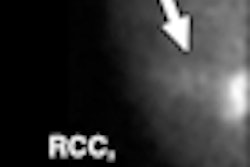For lung cancer patients undergoing chemotherapy and radiation, PET can be a good way to monitor and even predict treatment response. But the response measured in standardized uptake values (SUVs) can vary significantly depending on the facility in which SUV is measured.
At the American College of Radiology Imaging Network (ACRIN) 2008 fall meeting in Arlington, VA, Dr. Barry Siegel, professor of radiology and medicine at Washington University School of Medicine in St. Louis, discussed the preliminary results of a study led by his colleague Dr. Mitchell Machtay from Thomas Jefferson University in Philadelphia.
Siegel said that recent research from Australia (McManus et al) has shown that PET performed after completion of radiotherapy is a robust biomarker for risk stratification in patients with advanced non-small cell lung cancers (NSCLC).
"The response by PET ... turned out to be the most significant predictor of outcome in these patients," he said. "In comparison with anatomic imaging, there were far more complete responses by PET than could be seen by CT because there were residual masses so often."
In their ongoing study (ACRIN 6668) of about 250 patients with stage III NSCLC, Siegel and colleagues are evaluating post-treatment SUVpeak as a predictor of survival in these patients. As a secondary end point, they are also looking at the use of pretreatment SUVpeak as a biomarker to predict survival. A third aim is evaluating the reproducibility of SUV measurements acquired at the local imaging site versus a central laboratory.
"What we're focusing on today is whether what occurred in the field correlates with what occurred in the core lab with regard to measurement of SUVpeak," Siegel said.
As of the October ACRIN meeting, the group had enrolled about 209 patients in the multicenter study. Pretreatment FDG-PET scans from 56 patients and post-treatment FDG-PET scans had been analyzed to date, Siegel said.
The patients undergo baseline PET and then concurrent chemotherapy with or without adjuvant radiotherapy, he said. They receive follow-up PET imaging approximately 14 weeks after the completion of radiation therapy.
SUV data (SUVpeak) are determined at local institutions and reported to ACRIN on data collection forms. The actual FDG-PET datasets are also sent electronically to ACRIN for central review, where SUV is determined in a blinded fashion. Pearson and concordance correlations were performed.
Incidentally, he said, "SUV is not a sports utility vehicle," but rather a measure of the tissue concentration of FDG within a region of interest, divided by the average concentration in the body.
"There are a couple of different measurements: for example, SUVmax is the single pixel with the highest value, but because of concerns that there might be excessive noise in this max measurement, a number of investigators have used something called SUVpeak -- [representing] a small region of interest that is centered on the maximum SUV" rather than on a single pixel, Siegel explained.
Given the limited capabilities of currently available software, this measurement is partially manual and partially automated, he said. To measure SUVmax, "you find the tumor you want to measure, you localize the max pixel in that tumor, and you get the machine to define a 1-cm region of interest." If the max pixel (SUVmax) is 13.4, the region of interest or SUVpeak might be a little lower at 9.5, he said.
According to results reported in an abstract, the mean pretreatment SUV values at the local and central reviews were 9.02 ± 5.01 and 9.86 ± 4.37, respectively (Pearson correlation = 0.63, concordance correlation = 0.61).
"For the primary tumors ... on average the central reads gave a higher SUVpeak than the local reads for both the primary tumor and the regional lymph nodes," he said. "When you drill down to a point-by-point correlation, there is a reasonable Pearson coefficient of about 0.6, but in nearly 25% of cases (n = 14) there is a discordance of more than three SUV units between the central read and the local read -- and in some cases ... the difference is quite dramatic. Similarly with pretreatment, there are large discrepancies in more than a fifth of cases."
The mean post-treatment SUV values, as determined by local and central reviews, were 2.66 ± 1.85 and 2.56 ± 1.86, respectively (Pearson correlation = 0.67, concordance correlation = 0.64). In three cases (7.5%), the local and central review SUV differed by at least 3.0 absolute points. In eight cases (20%), the local and central review SUV differed by at least 1.5 points.
One potential cause of the discrepancies has to do with which lesions and which regions the reader selects as a region of high uptake, Siegel said in reference to a case with tracheal nodes showing at least three hot spots with different levels of FDG uptake.
In that case, the local reader interpreted regions of interest 1 and 2, and called region of interest 3 the primary tumor with an SUVpeak of 5. But the central reviewer called another region the primary tumor with an SUV peak of 9.4, Siegel said.
"So the interpretation of what lesion you're looking at is one potential problem," he said.
He concluded that, first, SUVpeak values drop in response to chemotherapy and radiotherapy for stage III NSCLC. With regard to variability of measurements, the correlation between local and central reads is good but not perfect, he said; overall, about 20% of cases show a substantial difference between the measurements of the core and central laboratories.
"We're still drilling into what the causes of these discordances are, and I think it gets into important things [we need] in the core lab: better automated methods for doing these measurements so less-subjective evaluation is involved, and better ways of reporting exactly what an observer did when he or she made a measurement."
By Eric Barnes
AuntMinnie.com staff writer
December 10, 2008
Related Reading
Dual-time-point FDG-PET/CT improves breast imaging accuracy, November 18, 2008
PET dose-painting methods produce discordant results, August 27, 2008
Intensity-modulated radiation therapy is inconsistently delivered, March 4, 2008
Measuring lung nodule growth beyond variability, November 5, 2007
SUV readings vary on different PET systems, study finds, July 25, 2007
Copyright © 2008 AuntMinnie.com



















